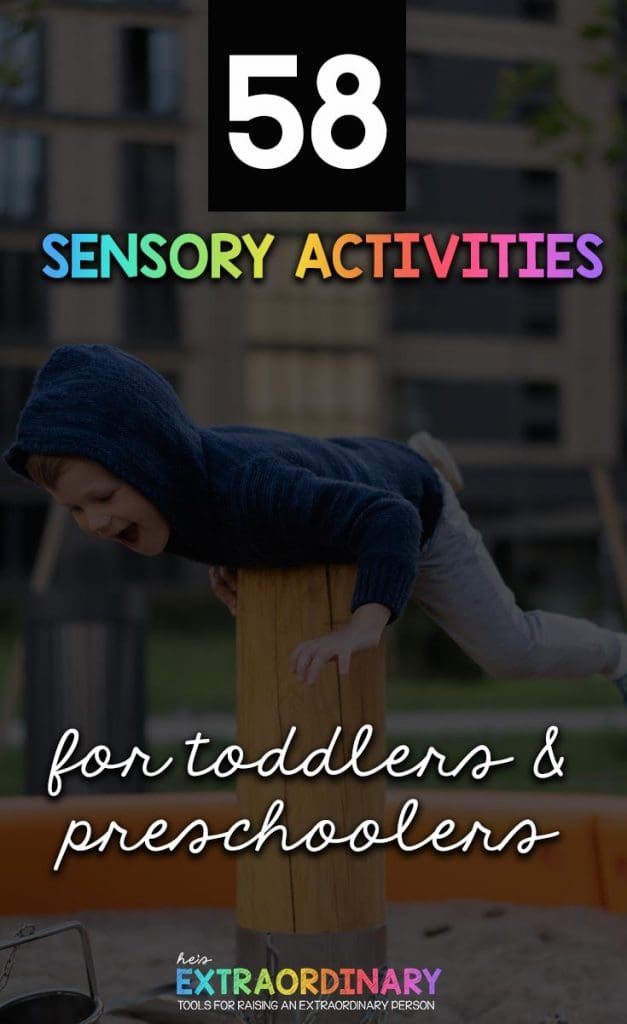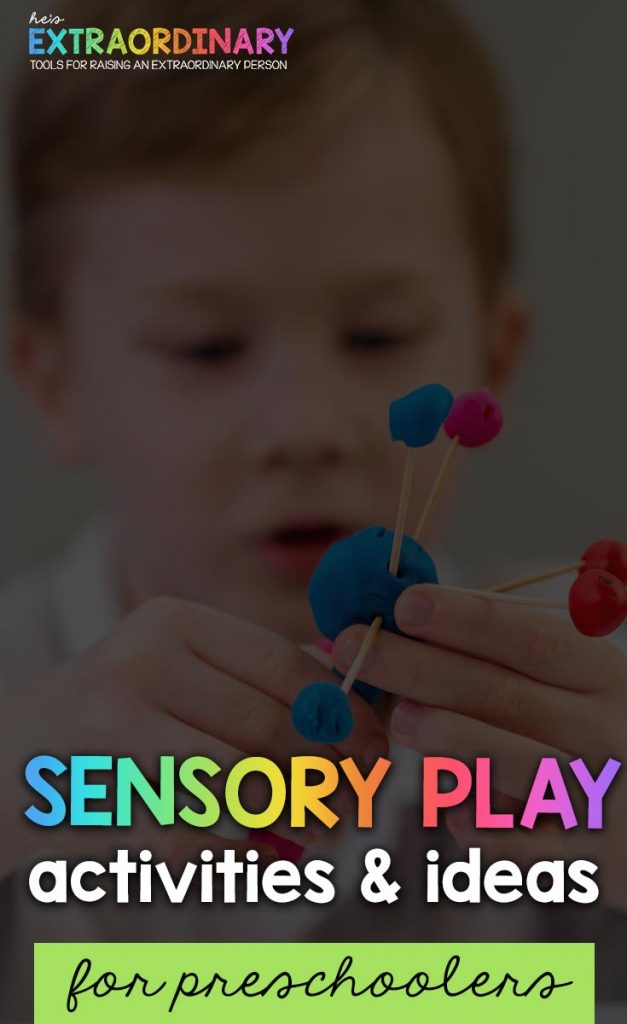58 Sensory Activities for Toddlers & Preschoolers
What’s inside this article: An overview of how sensory play helps toddlers & preschools, followed by 58 sensory activities suitable for toddlers and preschoolers.
Disclaimer: this post contains affiliate links
Sensory play is a crucial part of early childhood development and it’s beneficial to all children.
So, it’s great to have a ton of sensory ideas for your toddlers or preschoolers so you can expose them to a multitude of sensory experiences.
Children learn fastest through these hands-on sensory activities, developing muscle memory, and making connections about the world around them.
Every day you can help your preschooler discover new ways to interact and learn about the things around them.
How Does Sensory Play Help Preschoolers?
We receive hundreds of thousands of signals through our sensory systems every day. Then we process and interpret that information to create appropriate motor and behavioral responses.
Healthy sensory development begins in infancy. Learning to lift the head, and gain postural control and movement control – learning to sit, stand, roll – are the very first sensory processing skills to develop as a baby.
This development is lifelong but extremely important during early childhood.
As children grow and develop they begin to learn more complex skills, such as drawing with a crayon, walking, throwing a ball, and self-care skills like dressing.
Through sensory play, preschoolers will start developing crucial life skills such as:
- Fine motor skills
- Gross motor skills
- Balance and coordination
- Focus
- Self-regulation
- Self-care
- And more
Sensory Activities for Toddlers & Preschoolers

The more sensory ideas you have for preschool children to try, the better.
You want them to experience as much as possible from a young age to help their brain build connections and integrate the senses.
This list was compiled to help you find creative ways to engage in sensory play on a daily basis.
Hanging Upside Down
Activities that involve hanging upside down stimulate the vestibular system and have many benefits for people of all ages.
Learn how the vestibular system works here.
- Hang upside down from the couch
- Children’s yoga
- Hanging from the monkey bars
- Sit your child on your lap facing you and hold their hands while you let them drop back upside down over your knees, and then pull them back up slowly. Repeat.
- Lean backward over a large exercise ball.
Spinning
Spinning is another way to stimulate the vestibular system. Depending on how you spin, it can be either calming or alerting.
However, not all children react well to spinning so only use these sensory ideas if they’re enjoyable for your preschooler.
- Spin your child around in an office chair
- Play ring around the Rosie
- Roll down a big grassy hill
- Get your child to lay on their belly on a swing, twist it up and then let it go
Gross Motor Games
All of the classic gross-motor games that preschoolers play provide sensory input. They also help develop motor planning, balance, and coordination.
These are important building blocks later for more complex motor skills used in organized sports.
- Freeze Dance
- Simon Says
- Mother May I
- Tag – any kind of tag, here’s 10 fun tag games to try
- Hopscotch
- Jump rope
- Musical Chairs
- Tug of war
- Red light green light
Tactile Sensory Ideas
Tactile activities are anything that involves the sense of touch. Touch is a great way for children to learn about the world.
- Touch and feel books
- Slimes, doughs, and putties – try different kinds and talk about your experience. Is it slimy? Stretchy? Squishy or firm?
- Mix small toys in sensory bins filled with sand, flour, rice, or water beads and encourage your child to feel around to find them.
- Finger painting
- Play guessing games where your child closes their eyes and tries to guess what object you give them based on how it feels.
- Touch matching games – like playing memory but with different textures instead of photos
- Mystery Objects – Take 5 or 6 pairs of matching objects and put them in a bag. Have your child pull out one object, and then reach in the bag to find it’s pair relying on sight only.
- Writing letters in sand, or shaving cream with your fingers
Auditory Activities
These sensory ideas for preschool involve the auditory system – encouraging children to listen to and make different types of sounds.
- Telephone – This game is where everyone sits in a circle and someone starts with a message they whisper into the ear of the person beside them. Then that person whispers to the next person. You go all the way around the circle until the message reaches the last person. They say the message out loud and we see how accurate everyone was. It usually ends with a hilarious and completely different message than it started with.
- Musical toys such as shakers, drums, microphones, guitar, etc.
- Use lots of fun educational songs to reinforce new concepts. Such as counting songs, alphabet songs, shape songs, etc.
Visual Stimulation
Visual stimulation can help children develop the ability to notice patterns, pick out important information, and develop visual acuity.
- Optical illusions
- Sight word – word searches
- Puzzles
- I Spy
- Mazes
- Connect the dots
- Visually stimulating toys such as Kaleidoscope, View Finder, Spin Tops, Fidget Spinners, etc.
- Coloring – especially coloring pages with patterns and geometric shapes
Outdoor Activities
Outdoor play is important for early childhood development so incorporating sensory ideas into outdoor activities for preschool is a great way to help kids learn and get active.
- Nature walks
- Scavenger hunts
- Tree climbing
- Gardening – Gardening is a great heavy work activity. Get your child to help you with pulling weeds and digging, or adding fertilizer to the garden. Playing in the dirt is also a fun tactile experience.
- Water table
- Sand play – whether at a beach or in your own sandbox. Sand play offers preschoolers various tactile experiences as they work with wet sand, dry sand, and water.
- Biking – This helps develop bilateral coordination
Indoor Activities
Stuck inside and need a stimulating sensory idea for your preschooler?
- Build an obstacle course – Using household objects and furniture, create an obstacle course through the house for your child to jump over, crawl under, etc. Use couch cushions, chairs, and blankets to create tunnels, tape lines on the floor to jump on, etc.
- Have a pillow fight
- HIIT – High-intensity interval training as many benefits for kids. Try this printable activity: version one & version two.
- Yoga
- Paper Mache crafts (Recipe)
- Glitter jars
- Make “floam” – Recipe
- Science experiments – for example, dancing rice, elephant toothpaste, or rain cloud in a jar.
- Create a map of your body
- Dinosaur themed workout for kids


